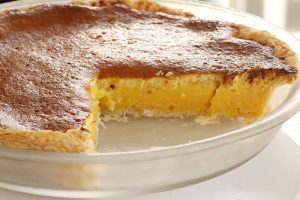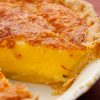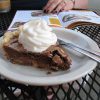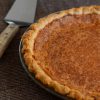Chess Pie: Just Custard Pie by Another Name

A few days ago, I was asked, "What's the difference between chess and custard pies?" My answer: Chess pies, of which there are many flavors, belong to the custard pie family and are therefore just a custard pie by a different name.
Most food historians agree that custard pie came to this country by way of English colonists who settled in New England and Virginia. A simple preparation, the basic custard pie is made from eggs, sugar, butter, milk or cream, and vanilla, baked in a pie shell until the mixture is set. Recipes can vary depending on the flavor desired.
Puddings cooked on top of the stove until thick and creamy are also custards. When these puddings are poured into a baked and cooled pie crust to set, we refer to the results as a cream pie--a topic for another day.
The one common element of all custard pies is that filling and crust are baked together. A few examples of custard pies include pumpkin, buttermilk, shoo-fly pie, and of course a whole family of chess pies.

As far as the origin of the name, there is no definitive explanation, only guesses and folklore. One such story is that of the southern plantation cook who when asked what she was baking replied, "Jes' pie."
Another explanation suggests that these icons of the American south are so sweet that refrigeration was not necessary and were therefore stored in the kitchen pie chest. Chest pie when pronounced with a deep southern drawl soon became "chess" pie. I find this explanation the most plausible.

While we may not be certain of its name, we do know there are references to chess pie as far back as 1877, when Estelle Woods Wilcox's cookbook Buckeye Cookery included a recipe by Miss J. Carson on page 187. Some fifty years later a recipe for the modern chess pie appeared in 1928 in Southern Cooking by Henrietta. R. Dull. That same year, a chess pie recipe was published in the Fort Worth Women's Club Cookbook.
The major difference in a chess pie from other custard pies is most chess pie recipes call for a small amount of cornmeal (or sometimes flour) to be added to the batter. This step not only helps the pie set, but adds texture as well. Also, chess pie recipes usually include some type of acidity in the form of vinegar, buttermilk, or lemon juice to help balance its sweetness.

I have included several chess pie recipes--the traditional version that uses only the four basic ingredients plus cornmeal, a slightly tart lemon chess, and a decadent chocolate chess pie. There is also a buttermilk chess pie and, of course, the classic pecan pie (yes, pecan pie is a member of the chess pie family). But a search through most community and church cookbooks will probably result in many more recipes for this simple yet delicious pie.
When making a chess pie (and any custard pie for that matter), just remember one golden rule: The successful chess pie is baked low and slow. Rushing a chess or custard pie by increasing the oven temperature will curdle the eggs, causing the pie to be watery. It may also cause a thin, ugly and nasty tasting crust to form over the top of the pie.
So there you have it, the difference in a chess and custard pie basically comes down to one ingredient--cornmeal.







